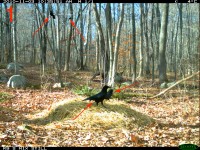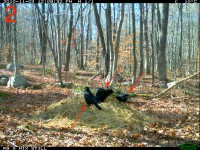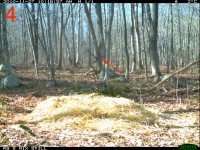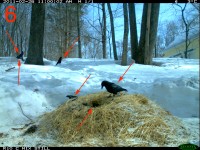Plain text indicates the location (see corresponding red arrow) of the animal(s) in image; bold text indicates the basis of the identification of the animal(s).
1 – Perched in tree (two) and on pile (two). [Four crows: the further perched individual is fairly challenging to spot. Comparison with the images surrounding this focal image is helpful to detect movement of objects (crows) in background. Diagnostic black plumage and legs.]
2 – On pile (three). [Three crows: bird in middle has its wings extended, rather than in the usual folded position, resulting in a challenging image. It was therefore counted as one individual and not an individual partially obscuring another conspecific located directly behind it. Diagnostic black plumage and legs.]
3 – In front of pile (one), in back of pile (one). [Two crows: the further bird is largely hidden by pile material. Diagnostic black plumage and legs.]
4 – In flight (one). [Single crow: blurred while flying. Dark object in green vegetation directly behind the pile is part of the surroundings and not a crow as revealed by its consistency in adjacent images. Diagnostic black plumage and legs.]
5 – On pile (four). [Four crows: three are readily visible, but one is partially obscured by pile material. Diagnostic black plumage and legs.]
6 – On pile (three) and in background (three). [Six crows: on pile one bird is obscured by material to left rear. Another is foraging while buried in pile, with only a small portion of its tail visible. The bird most clearly visible on the pile surface is looking down toward the buried bird. Careful examination of black object to left of large tree trunk near left side reveals two crows. For both the birds obscured in the background and in the pile itself, comparison with adjacent images is helpful to detect movement of objects (crows). Diagnostic black plumage and legs.]






